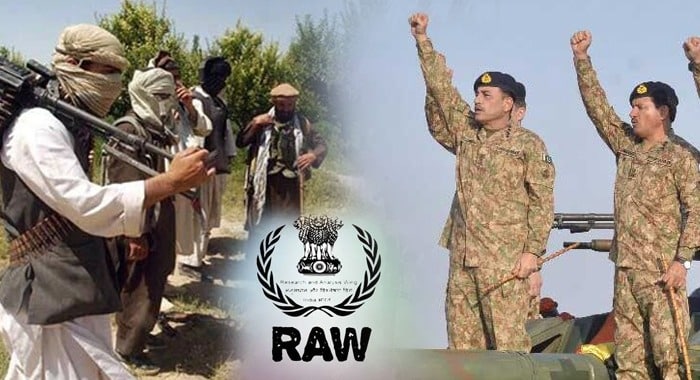Agha Syed Haider Shah
When the history of the 21st century is written, Pakistan will stand out as a nation that, despite relentless internal and international conspiracies, emerged stronger in its existential struggle. The corrupt strategic alliance between the United States and India was never solely about destabilizing Afghanistan; at its core, it was a concerted attempt to weaken Pakistan politically, economically, and socially dragging it into the quagmire of terrorism and unrest.
While Pakistan was labelled a front line ally in America’s so called War on Terror, the reality beneath this veneer was much darker. Covert operations by the CIA and India’s notorious intelligence agency, RAW, actively funded, armed, and trained anti-Pakistan elements in Balochistan, FATA, and urban centres. RAW exploited Afghan soil to create a vast terrorist infrastructure inside Pakistan. Militant groups such as the Baloch Liberation Army (BLA), Baloch Liberation Front (BLF), and Baloch Republican Army (BRA) were instrumentalized to carry out attacks, particularly in Balochistan.
But the conspiracy did not end there. The banned Tehreek-e-Taliban Pakistan (TTP) was given both sanctuary and strategic support. India facilitated their operations, while the Afghan government offered protection, and the United States turned a blind eye. Under the guise of Afghan Taliban control, the TTP orchestrated heinous attacks inside Pakistan the Army Public School massacre in Peshawar, the Mastung suicide bombing, the assault on the Quetta Police Training College, and numerous ambushes on security forces in Khyber Pakhtunkhwa. Who provided the financial lifelines, training camps, and intelligence support to these groups? The evidence resoundingly points to India operating from Afghan territory, under an American umbrella. The arrest of serving Indian naval officer and RAW operative Kulbhushan Jadhav stands as undeniable proof of these allegations.
Yet Pakistan did not remain passive. In response, the country initiated sweeping internal reforms. The National Action Plan (NAP) was implemented to uproot terrorism, ensuring strict surveillance of religious seminaries, regulating charity organisations, banning sectarian outfits, and empowering security institutions. Military courts were established to fast-track justice, and convicted terrorists were sentenced accordingly. Operations Zarb-e-Azb, Radd-ul-Fasaad, and Khyber-IV broke the back of terror networks across tribal areas, Balochistan, and major cities. Sleeper cells were dismantled, cross-border intrusions from India, Afghanistan, and even Iran were documented and presented to the world.
On the foreign policy front, Pakistan sent a clear message: it would no longer serve as a pawn in global proxy wars. The launch of the China Pakistan Economic Corridor (CPEC), a flagship initiative with China, rattled both India and the United States. India sought to sabotage the project by fuelling insurgency in Balochistan, but Pakistan responded by deploying dedicated security forces to protect Chinese engineers and infrastructure. This step restored confidence among international investors. Meanwhile, Islamabad pursued direct negotiations with the Afghan Taliban, demanding concrete action against TTP sanctuaries, and firmly told Washington: the era of “Do More” is over.
Pakistan also adopted an aggressive diplomatic posture on the international stage. From the United Nations to the Financial Action Task Force (FATF), it presented incontrovertible evidence of Indian involvement in terrorism. Whether it was the brutal suppression of Kashmiris or Indian sabotage in Balochistan, Pakistan’s diplomatic corps exposed India’s dual face a country persecuting its own minorities while sponsoring terrorism abroad. Pakistan’s eventual removal from FATF’s grey list affirmed global recognition of its counter terrorism efforts.
Domestically, Pakistan focused on ideological resilience. Educational curricula were revised to promote national unity and moderation. Schools and universities initiated awareness programs to inoculate the youth against radicalisation, while nationwide media campaigns countered extremist narratives. Coordination among intelligence agencies was significantly enhanced, and integrated data sharing frameworks were established between NADRA, FIA, ISI, and the police.
Even the Afghan Taliban now the de facto rulers of Afghanistan have come to realise that regional peace is unattainable without Pakistan’s involvement. Recent indications from Taliban leadership suggest a willingness to distance themselves from TTP, though implementation remains slow. Still, Pakistan’s policy is unambiguous: not an inch of its soil will be safe for terrorists.
In the past, Pakistan endured the presence of deadly groups like Lashkar-e-Jhangvi, Jundullah, Al-Qaeda, and ISIS-Khorasan. Yet, each met the same fate total eradication. Pakistan has not only neutralized internal threats but also sent an unmistakable signal to external foes: this is a nuclear nation with a united people and a battle-hardened military. No amount of deception or subversion can defeat it.
The battle is far from over, but the tide has turned. Today, Pakistan’s youth, armed forces, state institutions, and government are aligned in purpose. To its enemies, Pakistan issues a clear warning: this is a living, breathing nation, and no force on earth can bend a people whose roots are nourished by the blood of martyrs.





